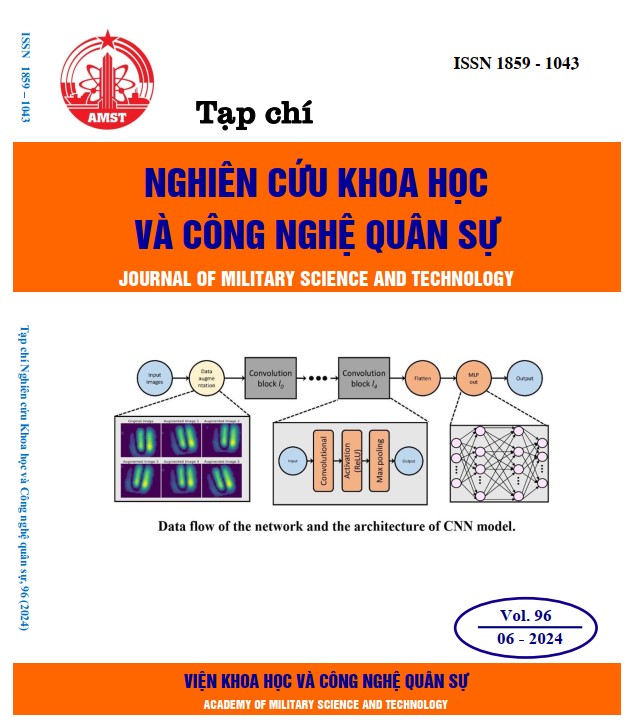Research on the effects of some factors on the adsorption capacity of 2,4-D in solution on carbon nanotube materials and activated carbon nanotubes
284 viewsDOI:
https://doi.org/10.54939/1859-1043.j.mst.96.2024.68-77Keywords:
Carbon nanotube; 2,4-dichlorophenoxyacetic acid; Adsorption; Triton X-100.Abstract
This article introduces the results of research investigating the effects of initial concentration 2,4-dichlorophenoxyacetic acid (2,4-D), temperature, pH, CaCl2 salt concentration and surfactant TX100 in solution on the 2,4-D adsorption capacity of carbon nanotube (CNTs) materials CNT-TC and CNT-HKi. Under the investigated conditions, CNT-HK7 had the highest ability to adsorb 2,4-D in solution. Progress 2,4-D adsorption of CNT-TC and CNT-HKi materials is exothermic and physical in nature, controlled by electrostatic interactions of solution. The presence of CaCl2 salt in the solution has created favorable conditions for the progress 2,4-D adsorption of CNT-TC and CNT-HKi. The presence of the active substance TX100 in the solution hinders the adsorption of 2,4-D by CNT-TC and CNT-HKi.
References
[1]. Phan Tống Sơn, Trần Quốc Sơn, Đặng Như Tại, “Cơ sở hóa học hữu cơ”, tập II, Xuất bản Đại học và Trung học Chuyên nghiệp (1980).
[2]. Kennepohl Elke, Munro Ian C., Bus James S., “Handbook of Pesticide Toxicology”, Academic Press, pp. 1829-1847, (2010). DOI: https://doi.org/10.1016/B978-0-12-374367-1.00084-7
[3]. Young Alin L., “The History, Use, Disposition and Environmental Fate of Agent Orange”, Spinger, pp. 45-61, (2012).
[4]. Jeanne Mager Stellman, Steven D. Stellman, Richard Christian, Tracy Weber, Carrie Tomassallo, “The extent and patterns of usage of Agent Orange and other herbicides in Vietnam”, Natura, 422, pp. 681-687, (2003). DOI: https://doi.org/10.1038/nature01537
[5]. Young A. L., Reggiani G. M., “Agent Orange and its associated dioxin: assessment of a controversy”, Elsevier, pp. 32-66, (1988).
[6]. Grover R., “Environmental Chemistry”, Volume 1, CRC Press (1988).
[7]. USAID, “Kế hoạch tổng thể Dự án xử lý ô nhiễm dioxin khu vực Sân bay Biên Hòa”, Cơ quan Phát triển Quốc tế Hoa kỳ, (2020).
[8]. Kim Hue Hoang, Vinh Anh Lam, Minh Cam Le, “Comparative Study of 2,4-Dichlorophenoxyacetic Acid Adsorption onto Alkali-activated Carbon Nanotubes and Activated Carbon”, Eleventh internation conference on the Remediation of chlorinated and Recalcitrant compounds, California, US, pp. 32, (2018).
[9]. Mohammednoor Altarawneh, Bogdan Z. Dlugogorski, Eric M. Kennedy, John C. Mackie, “Mechanisms for formation, chlorination, dechlorination and destruction of polychlorinated dibenzo - p - dioxins and dibenzofurans (PCDD/Fs)”, Progress in Energy and Combustion Science, 35, pp. 245- 274, (2009). DOI: https://doi.org/10.1016/j.pecs.2008.12.001
[10]. Rosa Axet M., R. Bacsa Revathi, F. Machado Bruno, Serp Philippe, “Handbook of Carbon Nano Meterials”, Francis D’Souza and Karl M Kadish 5, pp. 39-183, (2011).
[11]. Huỳnh Anh Hoàng, “Nghiên cứu tổng hợp, đặc trưng và một số ứng dụng của vật liệu Cacbon nano ống bằng phương pháp xúc tác lắng đọng Hóa học pha hơi khí dầu mỏ hóa lỏng (LPG) Việt Nam”, Luận án Tiến sĩ Hóa học, Viện Hóa học, (2012).
[12]. Hoàng Kim Huế, Lâm Vĩnh Ánh, Tô Văn Thiệp, Phùng Thị Lan, “Nghiên cứu tinh chế vật liệu ống nano cacbon ứng dụng hấp phụ chất diệt cỏ 2,4-D trong dung dịch nước”, Tạp chí Xúc tác và Hấp phụ Việt Nam, 6, 2, tr. 100-106, (2017).
[13]. Hoàng Kim Huế, Lâm Vĩnh Ánh, Tô Văn Thiệp, Nguyễn Hoàng Dũng, “Nghiên cứu hoạt hóa vật liệu ống nano cacbon ứng dụng hấp phụ 2,4-diclophenoxyaxetic axit trong dung dịch”, Tạp chí Nghiên cứu Khoa học và Công nghệ quân sự, 52, tr. 186 – 193, (2017).
[14]. Wu Wenhao, Chen Wei, Lin Daohui, Yang Kun, “Influence of Surface Oxidation of Multiwalled Carbon Nanotubes on the Adsorption Affinity and Capacity of Polar and Nonpolar Organic Compounds in Aqueous Phase”, Environmental Science and technology, 46, pp. 5446-5454, (2012). DOI: https://doi.org/10.1021/es3004848
[15]. Lopez - Ramon M.V., Stoeckli F., Moreno - Castilla C., Carrasco – Marin F., “On the characterization of acidic and basic surface sites on carbons by various techniques”, Carbon, 37, pp. 1215-1221, (1998). DOI: https://doi.org/10.1016/S0008-6223(98)00317-0
[16]. Sun Zhenyu, Liu Zhimin, Han Buxing, Wang Yong, Du Jimin, Xie Zailai, Han Guojun, “Fabrication of Ruthenium-Carbon Nanotube Nanocomposites in supercritical water”, Advanced Materials, 17, 7, pp. 928-932, (2005). DOI: https://doi.org/10.1002/adma.200400839
[17]. Hoàng Kim Huế, “Nghiên cứu sự hấp phụ 2,4-D và 2,4,5-T trong môi trường nước bằng vật liệu ống nano cacbon (CNTs)”, Luận án tiến sĩ Hóa học, Viện Khoa học và Công nghệ quân sự (2019).
[18]. Jie Ma, Fei Yu, Lu Zhou, Lu Jin, Mingxuan Yang, Jingshuai Luan, Yuhang Tang, Haibo Fan, Zhiwen Yuan, Junhong Chen, “Enhanced Adsorptive Removal of Methyl Orange and Methylene Blue from Aqueous Solution by Alkali - Activated Multiwalled Carbon Nanotubes”, ACS applied Materials & Interfaces, pp. 574 -5760, (2012).
[19]. Moradi O., “Adsorption Behavior of Basic Red 46 by Single - Walled Carbon Nanotubes Surfaces”, Fullerenes, Nanotubes, and Carbon Nanostructures, 21, pp. 286-301, (2013). DOI: https://doi.org/10.1080/1536383X.2011.572317







